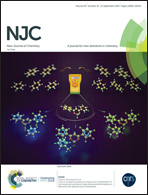Synergistic effect of 1-(2,5-dioxoimidazolidin-4-yl)urea and Tween-80 towards the corrosion mitigation of mild steel in HCl
Abstract
Herein, the synergistic effect of 1-(2,5-dioxoimidazolidin-4-yl)urea (DMU) and Tween-80 on the corrosion of mild steel in a 1 mol L−1 HCl solution was investigated by weight-loss tests, electrochemical methods and surface analysis (SEM/SECM). The experiments revealed that the combination of DMU and Tween-80 strongly inhibited the corrosion of mild steel as compared to individual inhibitors, and the adsorption mode belonged to the Langmuir isothermal type. Based on the electrochemical results, DMU and DMU–Tween-80 behaved as mixed-type inhibitors, and their best inhibition efficiencies were 77.31% and 96.35%, respectively. The calculated synergistic parameter value was larger than unity, indicating that the enhancement of inhibition efficiency was due to the synergistic effect of DMU and Tween-80. Surface analysis techniques confirmed the presence of inhibitors on the mild steel surface. Quantum chemical parameters based on density functional theory provided a further insight into the mechanism of inhibition. Moreover, molecular dynamics simulations were carried out to explore the configurational adsorption behaviour of DMU on an Fe(110) surface.



 Please wait while we load your content...
Please wait while we load your content...